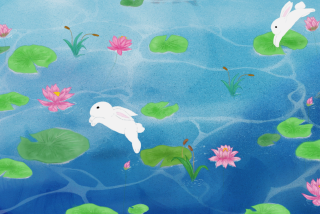One Enchanted Day When Peter Rabbit Stirred
- Share via
The names Flopsy, Mopsy and Cottontail have never figured very large in my adult vocabulary. Not that they weren’t there. They were just too deep in memory for easy retrieval.
Your average semi-macho guys, or even us everyday garden variety couch potatoes, just don’t tend to hang onto those memories we formed before being checked out on two-wheel bikes. Unless we’ve had a refresher course.
My wife and I recently had a refresher course.
A few months ago, we were in the Lake District of Cumbria--which is about hip high on the British Isles--and having a pretty good time. There aren’t a whole lot of places on this earth as pretty or as peaceful.
Many Lakes
We were told there are 23 lakes. Someone else said there are 19, so I suspect the total number sort of depends on whether or not it rained recently. I do know that however many there are, they’re in one of the most awe-inspiring settings.
Mile after mile of rolling meadows, forests and mountains, their tops frequently lost in cloud. There are fields of wildflowers, waterfalls and about every green that nature’s got.
There are sheep--armies of sheep, eating as fast as they can but never catching up with the growing landscape. And there’s something else . . . a feeling that goes with the territory.
Joyce and I were talking with Paul Carlin, a friend who’d come to the Lake District from London to manage the Borrowdale Gates Hotel near Keswick. He grinned as we raved about the countryside, as proud as if he’d created it himself.
Visitors From All Over
“It’s truly unique, you know, and I know what you mean about the feeling,” Carlin said. “People come to the Lake District from your Wisconsin and Minnesota, where lakes are common.
“Even from Colorado and British Columbia, whose mountains and lakes dwarf what we have here. And they’re just as enchanted as everyone else. And I think I know the reason. It’s not the lakes, you know.”
“What is it?” Joyce asked.
“Well,” Carlin said, “I’m almost afraid to talk about it.” He leaned forward and lowered his voice. “It may be something left over from the Druids or Merlin’s time, but I think it’s magic. I really believe there is a kind of enchantment here.”
We’d almost come to that conclusion on our own. You can’t drive through the area without having that thought. We’d recently visited Dove Cottage, where William Wordsworth lived with his family.
Though the cottage looks as if it’s 300 years old, it’s really kind of commonplace. The most unusual thing about it is that the children’s rooms are wallpapered with newspapers. (The guidebook said Wordsworth thought it would make the rooms warmer in the winter.)
Setting Is Unusual
But it’s not the cottage, it’s the setting that makes it unusual. When you see the view from the room where Wordsworth did his writing, you begin to understand.
You see Lake Grasmere cupped in rolling green hills, as still and reflecting as a mirror. The morning we were there, a few clouds were all but settling on its surface; you could feel a bit of the magic.
There was no way a man of Wordsworth’s talents could have lived in the area without becoming what he was--a poet laureate, the greatest poet on nature that England has produced.
“Wordsworth? Yes,” Carlin said. “ ‘Lucy,’ ‘The Solitary Reaper’ and ‘Daffodils’ are very nice. And you’ll never convince me that James Hilton didn’t spend some time here before he wrote about Shangri-La in ‘Lost Horizon,’ but I was thinking more in terms of Peter, Flopsy, Mopsy and Cottontail.”
“Who?” I asked.
“Peter Rabbit!” Joyce exclaimed. “That’s right! Beatrix Potter lived here in the Lake Country, didn’t she?”
Almost Missed House
“That’s what I meant by enchantment,” Carlin said. “Her house is just down the way. I’ll jot down some directions for you.”
It wasn’t “just down the way” at all. It was a couple of lakes and a few dozen turns down a long road, but the trip wasn’t a chore, because the country itself was satisfying.
We missed the house the first time and had to backtrack. We’d have missed it again, except a small sign said, “Hill Top House,” which my wife recognized from the stories.
At first there didn’t seem to be any true personality about the place. Slowly the lady herself, Beatrix Potter, began to take form as our guide walked us through the garden.
“It’s patterned after Mr. McGregor’s garden,” she said. “Does that ring a bell?”
Suddenly Interested
It meant something to most of the visitors, including Joyce, whose interest in the garden was suddenly aroused.
“Who’s McGregor?” I asked. “Refresh my memory.”
No one answered. They were all listening as the guide led us into the house. She explained how Miss Potter had lived in an era that expected all proper young women to go from their father’s house to their husband’s.
Beatrix, a very average-looking young lady who spent a good part of her growing-up years in the sparsely settled area, had been alone a lot. Having few callers and a great deal of time, she had taken to sketching and writing stories about the things she knew and loved, like the countryside and some of its inhabitants.
One of them was a very young rabbit, whom she named Peter. It wasn’t much of a story. It dealt with Peter leaving his siblings--Flopsy, Mopsy and Cottontail, who were “good little bunnies”--and going out and losing the new coat his mother had made him.
He lost it when he was almost caught by Mr. McGregor, whose garden Peter had been told never to visit.
Limited Edition
In 1902, probably more on the strength of the sketches than the stories, a London publisher took a chance and brought out a limited edition of “The Tale of Peter Rabbit.”
There were no limitations from then on. Beatrix Potter wrote and illustrated more than 25 children’s books, which were published in dozens of languages, to the delight of millions of children. And then their children and their children’s children.
“Did Beatrix Potter have children of her own?” someone asked.
“She eventually married a man named William Heelis,” the guide answered, “but she was childless.”
A woman asked if Miss Potter had been able to enjoy any of her success, or whether fame had only come after her death.
“She was a very canny lady who enjoyed huge success and made a great deal of money.”
Purchased Land
The tour group grew silent.
“In fact,” said the guide, “she loved the district so, that to have some control over what might happen to it, she began slowly buying up more and more property in the area to keep it from being destroyed by what the world calls ‘progress.’
“In addition to her writing, she spent her time working to protect all of this part of Cumbria, to keep it pure and unspoiled for all time. Her efforts are largely responsible for the fact that this whole district is now under the protection of the National Trust. God willing, and thanks to Beatrix Potter, it may be protected forever.”
The tour ended and we left the house, a few feet behind a young family. As we entered the garden again, a bird flew out of the hedge just in front of us. The daughter of the family, a girl of perhaps 4 or 5, heard the rustling noise and turned quickly.
Thought She Saw Him
“Oh, papa,” she said excitedly. The mother and father stopped and turned. The little girl spoke excitedly to her parents in a language neither Joyce nor I could understand. Her father answered her and then smiled at us.
“She wants to know was that Peter Rabbit who just came out of the bushes. I told her I didn’t know because I had not seen.”
The little girl thought for a few seconds and then, nodding her head firmly, spoke again. Her father translated.
“She says she thinks it was Peter Rabbit, that she thinks she caught a glimpse of him.” The little girl ran around looking under rose bushes and behind hedges for another glimpse as we approached the gate cottage.
Interesting Theory
Almost as a conspirator, the father shared a final thought with his wife and with us. “It probably was not really Peter Rabbit, you know. That rabbit would be 85 years old now.” He winked. “Probably one of his children or his grandchildren, huh?”
Carlin stopped by our dinner table in the hotel dining room that night and asked if we’d made it to Hill Top House and what we thought of his theory.
“You didn’t tell us what the lady had done for the district.”
“Or,” Joyce said, “that it was Peter Rabbit that really started it all.”
“And, I’ll bet,” Carlin said, “that they told you Beatrix Potter never had any children, too.”
“You mean she did?” I asked.
“The way I see it, she had millions of children . . . generations of millions of children,” he said. “And didn’t she leave them a lovely garden to play in?”
More to Read
Sign up for The Wild
We’ll help you find the best places to hike, bike and run, as well as the perfect silent spots for meditation and yoga.
You may occasionally receive promotional content from the Los Angeles Times.






